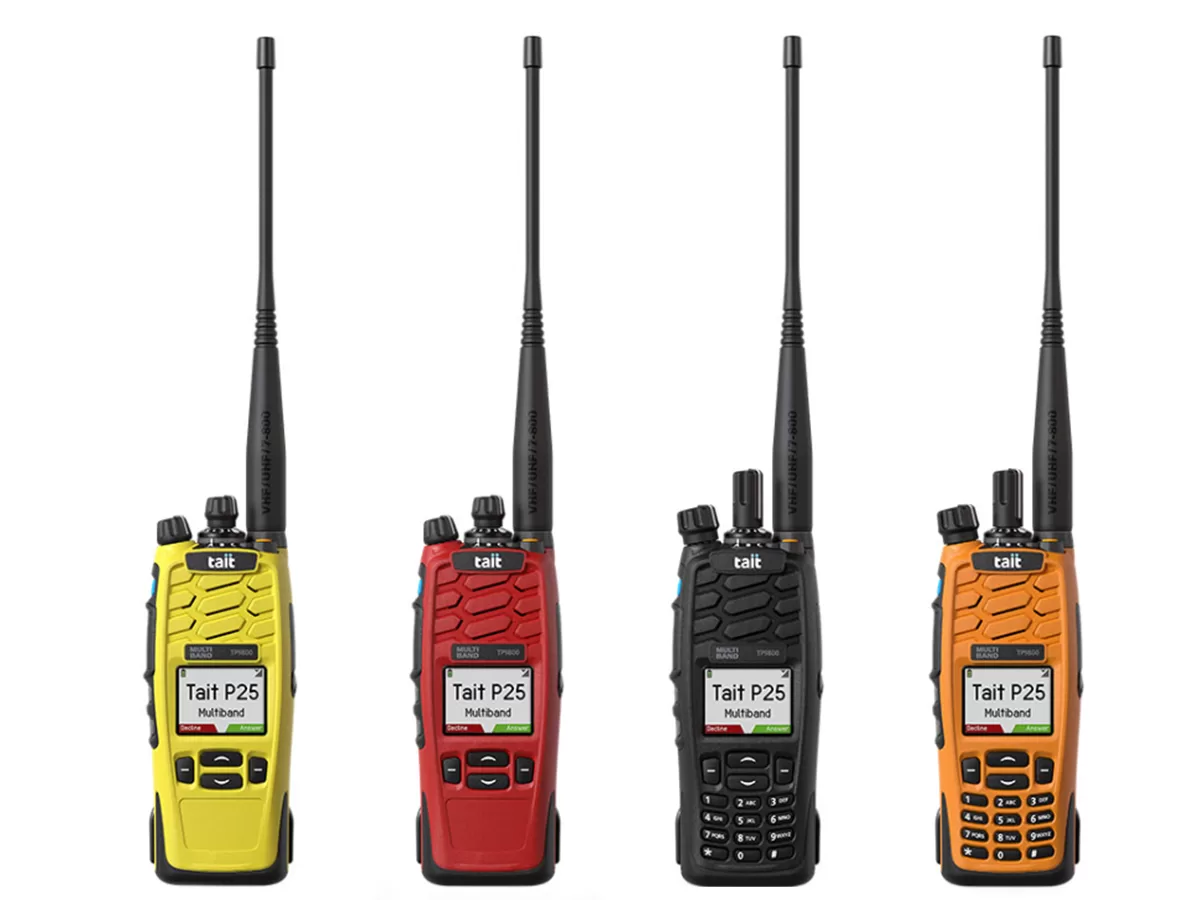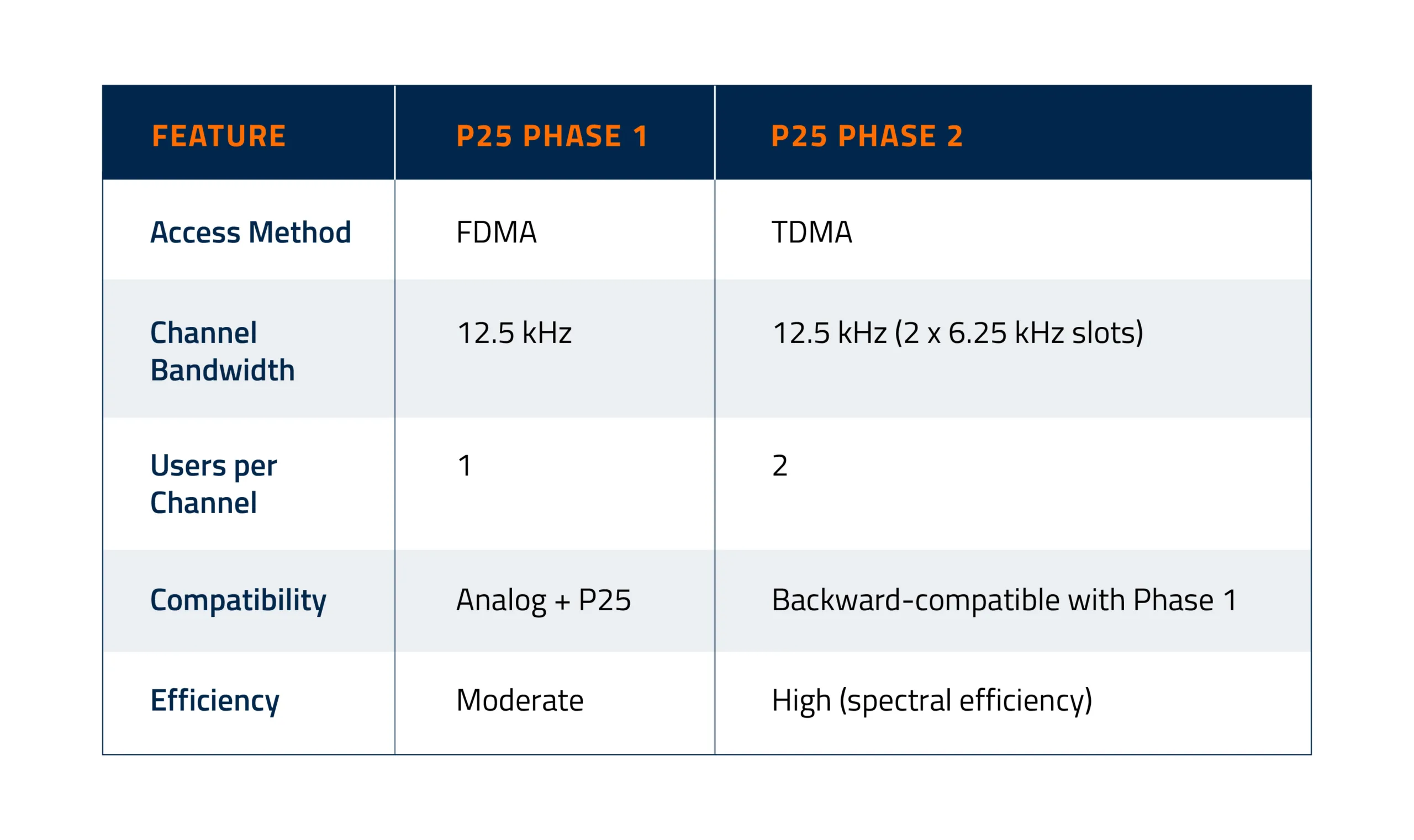P25 Standards Explained: Phase 1 vs. Phase 2 and Why It Matters

What Is Project 25 (P25)?
Project 25 (P25) is a suite of standards for digital land mobile radio (LMR) systems used by public safety, utilities, military, and critical infrastructure. Managed by the Association of Public-Safety Communications Officials (APCO)and standardized by the TIA (Telecommunications Industry Association), P25 was designed to ensure:
- Interoperability: Radios from different vendors and agencies can communicate seamlessly.
- Future-readiness: Standards evolve with technology, protecting investments.
- Mission-critical performance: Rugged, reliable communication even in the harshest environments.
P25 supports both analog and digital modes, allowing agencies to migrate gradually without replacing entire fleets overnight. Today, most agencies are moving from analog or P25 Phase 1 systems to P25 Phase 2 to improve spectrum efficiency and performance.
P25 Phase 1 vs Phase 2: The Core Difference
The P25 standard is implemented in two main phases. Understanding the difference between Phase 1 (FDMA) and Phase 2 (TDMA) is critical for agencies planning upgrades.
P25 Phase 1: FDMA Technology
- Access Method: Frequency Division Multiple Access (FDMA).
- Channel Bandwidth: 12.5 kHz channels.
- Operation: Each user occupies a dedicated 12.5 kHz channel during transmission.
- Compatibility: Backward-compatible with analog systems (many Phase 1 radios can also operate in analog).
- Advantages: Simpler implementation, interoperability with legacy analog radios, strong audio clarity.
- Limitations: Less efficient spectrum usage, fewer channels available in congested regions.
P25 Phase 2: TDMA Technology
- Access Method: Time Division Multiple Access (TDMA).
- Channel Bandwidth: 12.5 kHz channels split into two 6.25 kHz time slots.
- Operation: Two users share the same 12.5 kHz channel, transmitting in alternating time slots.
- Compatibility: Phase 2 radios maintain backward compatibility with Phase 1 systems.
- Advantages: Doubles capacity without requiring new spectrum allocations.
- Limitations: Slightly higher system complexity; infrastructure upgrades may be required.
Quick Comparison: P25 Phase 1 vs Phase 2

Why Phase 2 Delivers Better Performance
The push from Phase 1 to Phase 2 was driven by one major factor: spectrum efficiency.
Spectral Efficiency
- With growing demand for wireless communication, the available spectrum for public safety is limited.
- Phase 2’s TDMA doubles channel capacity by allowing two simultaneous conversations in the same 12.5 kHz bandwidth.
- Agencies effectively get more capacity without needing new spectrum licenses.
Enhanced Capacity for Agencies
- Agencies with large workforces (police, fire, EMS, utilities) benefit from expanded channel availability.
- Phase 2 reduces congestion during large-scale incidents or events involving multiple agencies.
Improved Network Performance
- TDMA technology improves system capacity while maintaining audio clarity.
- Digital voice with error correction ensures intelligibility even in fringe coverage areas.
Bottom line: For agencies facing spectrum scarcity, growing demand, or multi-agency coordination, Phase 2 offers clear operational and financial advantages.
The Migration Path: Analog → Phase 1 → Phase 2
Agencies rarely switch overnight from analog to Phase 2. Instead, most follow a staged migration path that balances cost, training, and infrastructure readiness.
Step 1: Analog Systems
- Many agencies still operate on analog LMR systems.
- Analog radios are simple but lack encryption, advanced features, and spectrum efficiency.
- Coverage in fringe areas can be poor, with static and noise.
Step 2: P25 Phase 1 Adoption
- Agencies upgrade to P25 Phase 1 radios, gaining digital clarity, encryption, and interoperability.
- Many radios (like Tait TP9400 or TP9600) support dual modes, allowing analog + Phase 1 operation.
- This ensures a smooth transition while keeping legacy analog equipment in use.
Step 3: Migration to Phase 2
- Agencies eventually move to Phase 2 for spectral efficiency and greater capacity.
- Phase 2-capable radios (like Tait TP9800 or TP9900 multiband models) support both Phase 1 and Phase 2.
- Infrastructure upgrades (repeaters, base stations) may be required, but PMC Wireless helps plan phased rollouts to minimize disruption.
Flexible Transition
With hybrid radios and incremental infrastructure upgrades, agencies can control costs and timelines while steadily modernizing their networks.
Use Cases: Agencies at Different Stages
Agencies Still on Analog
- Who they are: Smaller municipalities, volunteer fire departments, or rural utilities.
- Challenges: Limited budgets, legacy equipment, resistance to change.
- Solution: Deploy hybrid radios that support both analog and digital, allowing phased adoption.
Agencies Using P25 Phase 1
- Who they are: Medium-sized cities, industrial operations, or statewide agencies with partial digital systems.
- Challenges: Increasing channel congestion, more multi-agency incidents requiring interoperability.
- Solution: Plan for Phase 2-capable radios to prepare for spectrum efficiency requirements.
Agencies Operating on P25 Phase 2
- Who they are: Large metropolitan police/fire departments, statewide systems, transportation agencies.
- Benefits: Higher capacity, fewer dropped calls, compliance with future FCC requirements.
- Solution: Optimize network infrastructure (simulcast, trunked networks) and maintain software/firmware updates.
Takeaway: Whether an agency is on analog, Phase 1, or Phase 2, PMC Wireless offers solutions to ensure smooth migration and reliable performance.
PMC Wireless & Tait: Partners in P25 Migration
Choosing the right radios and infrastructure is only part of the challenge, successful migration requires planning, engineering, and support. That’s where PMC Wireless comes in.
How We Help
- Coverage Assessments & RF Surveys: Identify current performance gaps.
- Migration Planning: Tailor paths from analog → Phase 1 → Phase 2 based on budgets and timelines.
- Radio Selection: From rugged TP9400 and TP9600 to multiband TP9800/TP9900, PMC helps agencies choose the right mix.
- Infrastructure Upgrades: Deploy and configure TB9400 base stations, repeaters, trunked networks, and simulcast systems.
- Training & Support: Ensure users, dispatch, and IT teams are fully prepared.
- Maintenance Contracts: Keep systems reliable with ongoing testing, firmware updates, and service.
With PMC Wireless and Tait, agencies get future-proof digital public safety radios backed by hands-on support.
Conclusion: Why P25 Standards Matter Now More Than Ever
Clear, reliable communication is the backbone of public safety. Understanding P25 standards, and the differences between Phase 1 (FDMA) and Phase 2 (TDMA), is essential for agencies planning upgrades.
- Phase 1 delivers strong digital performance and backward compatibility with analog systems.
- Phase 2 offers greater efficiency, capacity, and long-term value.
- Migration from analog → Phase 1 → Phase 2 allows agencies to modernize at their own pace.
At PMC Wireless, we help agencies make the business and technical case for migration, ensuring investments pay off in safety, compliance, and reliability.
Contact PMC Wireless today to schedule a consultation. Let’s design a migration path that gets your team connected, compliant, and ready for the future of P25.